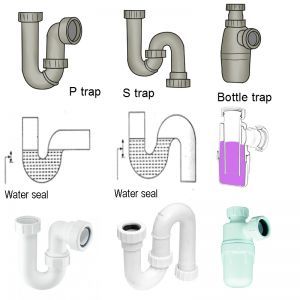Bottle Trap For Bathroom Sink

Sink, Wash Basin And Urinal Traps Explained
Waste water from your sinks, basins, baths and toilets is disposed of into the foul water drainage system. This system deals with a lot of waste, which leads to a large build-up of bad smelling gas which you will want to prevent entering your building. The solution is the often forgotten waste water trap.
Every sink, wash basin, and urinal discharging water inside a building requires a water trap at the point of connection into the waste pipework. The water trap provides a water seal between the appliance and the external drains or outside atmosphere. The water trap will prevent smells, insects and bacteria coming back up the waste pipework into your building.
The trap will only work and prevent smells when it has water inside which provides the water seal.
The size of the trap will depend on the type of appliance and the size of your waste pipework. Generally, the following types of appliances use a standard size waste trap and waste pipework:
Wash hand basins: 32mm (1 ¼ inch).
Sinks: 38mm (1 ½ inch).
Urinals: 38mm (1 ½ inch), or 50mm (2 inch).
Sizes stated are based on the internal pipe diameter, external pipe diameters may vary between different manufacturers and may not always be interchangeable.
The water traps function is to provide a water seal in the pipework which effectively isolates the appliance from the drainage system.
The depth of seal in the water trap needs to be a minimum of 75mm to comply with new build regulations where waste water discharges into a single stack waste system.
Below are the common types of trap which are used on installations of sinks, basins and urinals.
B ott le traps have a horizontal waste water outlet and the lower half unscrews to allow the clearing of debris and blockages. Bottle traps require less space than P or S traps under the appliance and are ideal where space is limited. Due to their design, they can be prone to trapping debris.
P traps have a horizontal waste water outlet and usually have a screw coupling in the middle to allow the outlet to be rotated to the correct angle for installation. This type of trap allows free flowing waste water and are less prone to blockages and a build-up of debris. They do however require more space than a bottle trap.
S traps are manufactured in an S shape with a water outlet pointing downwards. They can be adjusted via a centre swivel joint to align with the drainage pipework for ease of installation. The free flowing shape allows the water to drain away quickly reducing the accumulation of dirt in the trap to help prevent blockages. More space is required for an S trap than a bottle trap.
Traps with washing machine connections
Traps with dishwasher connections.
Twin bowl sink traps.
Shallow traps for baths and showers – may not conform to regulations.
100mm (4 inch) toilet traps.
Source: https://www.washwareessentials.co.uk/content/Traps
